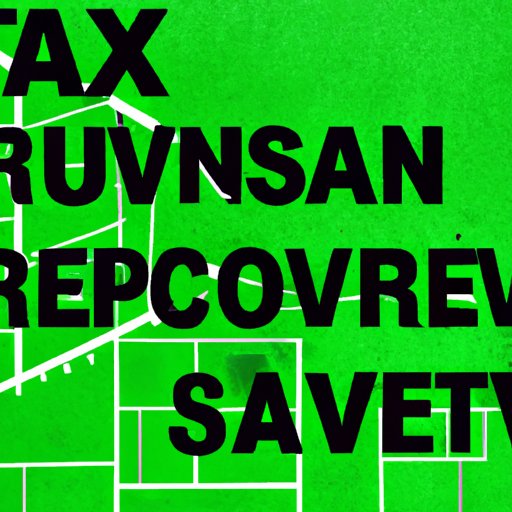
I. Introduction
It’s tax season, and many Americans are wondering where their hard-earned money is going once it’s in the hands of the government. Without a clear understanding of how tax revenue is allocated, it’s easy to feel frustrated or resentful about paying taxes. However, getting informed about government spending can help you feel more empowered and knowledgeable when it comes to your finances.
This article will explore the different ways your tax dollars are spent in the United States, from funding infrastructure to supporting social security. We’ll also look at how tax shelters and evasion impact government revenue, and how tax credits and deductions can help you keep more of your own money. Finally, we’ll consider some of the potential changes to tax policy and collection in the near future.
II. The Basics: Understanding Where Your Tax Dollars Go
Before we dive into specific spending categories, let’s review some basic concepts related to taxes and revenue.
A. Definition of taxes and tax revenue
Taxes are a form of monetary payment required by law of individuals and businesses. Tax revenue is the money collected from taxes and used by governments to fund public goods and services. In the United States, there are numerous types of taxes, including income tax, payroll tax, property tax, sales tax, and excise tax, just to name a few.
B. Federal budget breakdown
The federal budget is divided into multiple categories, including mandatory spending programs, discretionary spending programs, and interest on the national debt. Mandatory spending includes programs like social security and Medicare, while discretionary spending includes items like funding for education, transportation, and national defense. Interest on the national debt is the cost of interest payments on loans the government has taken out over time.
C. State and local tax revenue breakdown
While federal taxes garner the most attention, state and local taxes add up to a significant percentage of government revenue as well. State and local taxes can include sales tax, property tax, and income tax, among others. These taxes typically fund state-level programs like schools, healthcare, and infrastructure.

III. From Schools to Roads: How Your Tax Dollars Build Our Communities
Now let’s look at some of the specific ways your tax dollars are spent at the federal, state, and local levels.
A. Funding for education
One of the biggest areas of government spending is education. At the federal level, a significant portion of education funding goes towards financial aid for college students. State and local taxes pay for things like teacher salaries, textbooks, and school maintenance. Funding for education is a major topic of debate among policymakers, with some arguing for increased funding for schools and others suggesting that education spending is already too high.
B. Infrastructure and public works
Another significant area of government spending is infrastructure and public works, which includes things like roads, bridges, and public transportation. In addition to improving public safety and quality of life, infrastructure investments can help boost economic growth by creating jobs and increasing efficiency. Some critics argue that the government is spending too little on infrastructure, and that more investment is needed to keep up with the aging roads and bridges across the country.
C. Government programs and public services
In addition to education and infrastructure, the government funds a wide range of other programs and services. Examples include healthcare programs like Medicaid and children’s health insurance, food assistance programs like SNAP, and environmental protection initiatives like the EPA. The government also provides subsidies and grants to individuals and businesses in certain industries, such as agriculture and renewable energy. The extent and focus of these programs can vary widely depending on the political climate and priorities of policymakers.
IV. Defense, Healthcare, and Social Security: The Biggest Recipients of Your Tax Money
While different areas of government spending receive varying amounts of funding, some categories consistently receive the lion’s share of tax revenue. Let’s take a closer look at three of the largest recipients of tax dollars in the United States.
A. Military spending and national defense
By far the largest area of discretionary federal spending is national defense. Military spending funds initiatives like troop salaries, weapons development, and research, and accounts for over half of the entire discretionary budget. Some have criticized the high levels of defense spending, arguing that it siphons resources away from other important programs. Others believe that national security requires a strong military presence and investment in advanced technology and infrastructure.
B. Healthcare and medical research funding
Another major area of government spending is healthcare and medical research. In addition to funding programs like Medicaid, the government also invests heavily in medical research and development. This funding supports initiatives like finding a cure for cancer or improving healthcare outcomes for people with chronic diseases. Despite the benefits of these efforts, some critics argue that the high cost of healthcare is an unsustainable burden on taxpayers and the government.
C. Social security and retirement benefits
Finally, social security and retirement benefits represent a significant share of government spending. These programs are funded through payroll taxes, and provide income support and healthcare assistance to millions of elderly or disabled Americans. While social security has been a mainstay of government spending for decades, some policymakers argue that the system is unsustainable in its current form and will require significant revisions to remain viable in the long term.
V. The Impact of Tax Shelters and Loopholes: A Look at Where Money Slips Through the Cracks
While the government collects significant amounts of tax revenue each year, not all taxpayers are contributing their fair share. Let’s explore some of the ways that tax shelters and loopholes can reduce government revenue.
A. Definition of tax shelters and loopholes
A tax shelter is a legal mechanism that allows taxpayers to reduce the amount of taxes they owe. Examples of tax shelters include investments in real estate, charitable deductions, and offshore bank accounts. “Loopholes” refer to ways that taxpayers can exploit gaps or weaknesses in tax law to avoid paying taxes altogether.
B. Examples of tax avoidance and evasion
Some high-profile examples of tax evasion include celebrities like Wesley Snipes and Martha Stewart, who were both sentenced to prison for tax-related crimes. Other examples include multinational corporations that use complex accounting techniques to move profits and assets overseas in order to avoid paying taxes in the US.
C. The impact on government revenue and the economy
The IRS estimates that each year, hundreds of billions of dollars go uncollected due to tax evasion and noncompliance. While some taxpayers may not be able to afford to pay all of their taxes, others are simply taking advantage of legal loopholes. Regardless of the means, this lost revenue can impact government programs and economic growth over time.
VI. Putting Money Back in Your Pocket: How Tax Credits and Deductions Help You Keep More of Your Money
While some tax-sheltering schemes may not be legal or ethical, there are other ways that taxpayers can benefit from tax breaks in a legitimate way.
A. Definition of tax credits and deductions
Tax credits and deductions are two types of tax breaks that allow taxpayers to reduce the amount of taxes they owe. Tax credits are subtracted directly from the amount of taxes owed, while deductions reduce taxable income before taxes are calculated.
B. Common tax breaks for individuals and businesses
Examples of tax credits for individuals include the child tax credit, the earned income tax credit, and the retirement saver’s tax credit. Business tax credits can include things like research and development credits, energy-saving credits, and work opportunity credits.
C. How to claim tax credits and deductions
Claiming tax credits and deductions can be more complicated than simply filling out a tax form, but there are resources available to help. You can find information on eligible credits and deductions on the IRS website, or hire a tax professional to assist you.
VII. The Dark Side of Tax Evasion: How a Failure to Pay Up Affects Everyone
While some taxpayers may see tax evasion as a victimless crime, the impact of lost revenue can be significant for society as a whole.
A. Definition of tax evasion
Tax evasion refers to the illegal practice of not paying taxes owed to the government. This can involve underreporting income, claiming false deductions, or failing to report offshore income.
B. Consequences of tax evasion for individuals and society
Individuals who are caught evading taxes can face serious consequences, including fines, penalties, and even criminal prosecution. More broadly, tax evasion can lead to reduced government revenue, which can result in a lower quality of public services for everyone. Tax evasion can also contribute to a culture of distrust and a lack of faith in government institutions.
C. Examples of high-profile tax evasion cases
Some of the most high-profile tax evasion cases include the notorious Panama Papers scandal, in which wealthy individuals and corporations used offshore tax shelters to avoid paying taxes. Other well-known examples include Leona Helmsley, a hotel mogul who famously declared that “only the little people pay taxes,” and Al Capone, who was ultimately convicted of tax evasion rather than the more serious crimes he was known for.
VIII. The Future of Taxation: How Tech Advances and Political Changes Could Affect the Way We Pay Taxes
In addition to the way taxes are currently collected and spent, there are also a number of changes on the horizon that could transform the tax landscape in the coming years.
A. Technological advances in tax collection and enforcement
Advances in technology, such as data analytics and machine learning, are already providing new avenues for tax authorities to track down tax evaders and noncompliant taxpayers. In the future, these tools could become even more sophisticated and improve the efficiency of the overall tax system.
B. Potential changes to tax policy and laws
Policymakers are constantly discussing and debating changes to tax policy, ranging from minor adjustments to big overhauls of the tax code. These changes can have a significant impact on taxpayers, especially those in certain income brackets or industries. The most recent major tax law overhaul in the US was the Tax Cuts and Jobs Act of 2017, which made sweeping changes to everything from corporate tax rates to deductions for individuals.
C. The impact of political shifts on tax revenue and spending
Finally, the political climate and priorities of elected officials can also have an impact on government tax revenue and spending. Different political parties and ideologies may prioritize different areas of government spending, and may have differing views on the appropriate level of taxation overall.
IX. Conclusion
Understanding how your tax dollars are spent is an important step towards being a more informed and engaged citizen. By understanding where revenue comes from and what it funds, you can be better equipped to make decisions about your own finances and to participate in important policy debates.
While the way tax revenue is allocated can be complex and at times controversial, there are few issues more central to government and to public life in general. Whether you’re a taxpayer or a policymaker, getting informed about taxes and government spending is an essential part of being a responsible member of society.
If you’d like to learn more about how taxes and revenue work in the United States, there are many resources available, including government websites, tax professionals, and advocacy groups. By educating yourself and staying informed, you can make sure that your money is being used in a way that aligns with your values and priorities.





